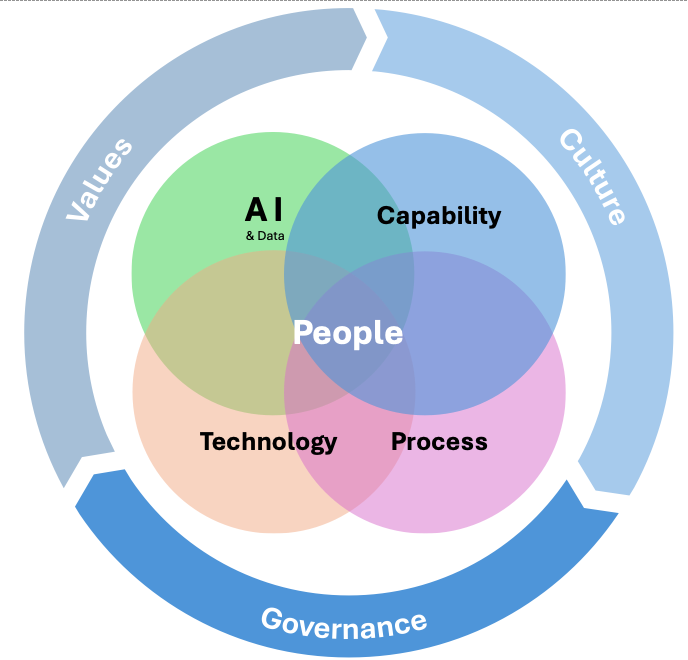The Importance of Harnessing Your Employees’ Creativity and Ideas for Business Impact in the current AI-powered World
The advent of generative artificial intelligence (AI), on top of the myriad of digital advancements already underway, has ushered in a new era of The Innovation Imperative. It is no longer enough to just introduce new products, services, processes; you must also rethink your business model, how it operates, and your value proposition to all stakeholders.
Understanding Innovation
Innovation encompasses more than invention and the introduction of new technologies, products or processes; it is also about applying existing ideas in new ways to deliver new impact. It is not confined to the R&D department but needs to be a core business capability and embedded across all levels of an organisation. ‘The Innovation Imperative’ extends this understanding to focus on the application of innovation to solve real and compelling problems, distinguishing between what is ‘nice’ to solve and what ‘must’ be solved in a world of constant uncertainty and disruption.
In many cases, we have seen the ‘invention’ is the end of the story. Funding the development is not the same as commercialisation which requires measurable, visible impact, i.e. what will the application of the innovation achieve?
Sources of Innovation
Innovators need to look beyond one's immediate industry, geographical boundaries and even time period for inspiration. Innovation can often be found at the intersection of diverse fields, where principles and ideas from one domain can be adapted to solve challenges in another. This cross-pollination of ideas not only reduces risk but also accelerates the path to impactful solutions. Eclectic sources and influences create stimulation and should be actively sought.
The Human Element
A common pitfall in the pursuit of innovation is the overemphasis on technology or processes at the expense of the human element. Ultimately, innovation serves people, whether they are customers, partners or employees. Diversity within the workforce is not just a moral imperative but a strategic one. Diverse teams bring a variety of perspectives, experiences, and ideas, significantly enhancing the organisation's innovation capabilities.
There is an important external factor here, including the people who apply the innovation and the investors in its development. Investors may have more than commercial reasons for investing, e.g. philanthropic, social impact.
Cultivating the Right Culture and Motivating Risk-taking
For innovation to transition from abstract ideas to concrete impact drivers with tangible outcomes, an organisational culture that supports risk-taking, learning, and adaptability is essential. Shifting the narrative from "Why?" to "Why not?" encourages a mindset that evaluates the risks of inaction as critically as the risks of action. The fear of missing out (FOMO), can serve as a powerful motivator, driving the adoption of new technologies and ideas by emphasising the potential losses of inaction rather than just the benefits of innovation. Rewarding and incentivising risk management and learning over risk aversion also supports the cultivation of an innovative culture.
Calls to Action
1. Engage in an innovation capability assessment: Evaluate your organisation's capabilities, culture and risk management practices for innovation. Understanding your workforce norms is the first step towards fostering a culture that embraces innovation and unlocks the creative potential of your people.
2. Connect innovation to impact: Develop a framework for encouraging, identifying, and harvesting ideas from across your organisation while developing capabilities to connect innovation to impact.
3. Experiment with AI to amplify your innovation capacity: Create environments for your teams to experiment with AI tools to expand and extend their innovation capabilities.
Conclusion
In essence, the Innovation Imperative is how you can build new business capabilities, introduce new products and services, and deliver new value propositions to your stakeholders, all at speed and scale, with significant, measurable business impact.

Figure 1: The “People-Process-Technology” (PPT) framework updated for the AI-era
It integrates technology, processes, AI and capability building, centred around your people. It requires looking beyond conventional boundaries for inspiration and fostering a culture that values diversity and risk-taking. For example, consider the slow-moving pharmaceutical industry, where it typically takes 12-15 years to bring a new drug to market. AI-driven R&D could reduce the time it takes for a drug candidate to be ready for human testing by 25-50%. A new business and operating model is required to cope with this speed.
By redefining how problems are framed and embracing a culture that shifts from protecting the status quo to challenging it, organisations can harness their employees' creativity and ideas for significant business impact. Organisations that don’t achieve this will struggle to compete commercially.
Acknowledgements
The primary source of content for this article was from experts in the Capability Network. AI tools were used to synthesise and accelerate document production.
About Capability
Capability helps many of Australia’s leading organisations grow, digitalise, and optimise their business through execution capability. As a boutique Melbourne-based management consultancy, we differentiate our services through thoughtful balancing of strategy and governance advice with decades of pragmatic implementation experience. Our leaders are distinguished by their repeated success through multiple organisations, and all have previously held leadership roles in both professional services and industry.
About the Authors
|
|
Gerry Barr Partner
|
|
|
David Yip Partner & AI and Education Leader |
|
Gerry has substantial experience helping companies strategically improve their businesses, including the identification and management of growth initiatives. |
|
David is an entrepreneurial and visionary technology growth executive with over 20 years experience. He has held executive roles and consulted across education, government, finance, utilities, telco and retail.. |
||




